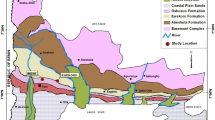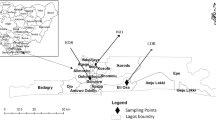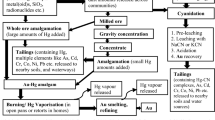Abstract
A “multi-pollutant exposure programme” reflecting the new pollution situation where SO2 is no longer the dominating pollutant has been performed by the International Co-operative Programme on Effects on Materials, including Historic and Cultural Monuments (ICP Materials) within the activities of the Convention on Long-range Transboundary Air Pollution. The main results obtained in the period 1997–2003 are summarised. Dose-response functions are presented for carbon steel, zinc, copper, bronze and limestone. Parameters involved in the functions include besides SO2 and pH, which were included in the previously developed functions from ICP Materials, also the effect of particulate matter and HNO3.
Similar content being viewed by others
Explore related subjects
Discover the latest articles, news and stories from top researchers in related subjects.Avoid common mistakes on your manuscript.
1 Introduction
Dose-response functions are an important tool for mapping areas of increased risk of corrosion and for calculating corrosion costs. In the past, several dose-response functions for individual materials have been proposed using results based on different exposure programmes, for example the NAPAP programme (Baedecker, 1990) and Scandinavian exposure programmes (Haagenrud & Henriksen, 1996). Common for the past exposure programmes and functions was the focus on the SO2 concentration, which was the main corrosion stimulator. Therefore, all these functions should in principle be denoted “dose-response functions for the SO2 dominating situation”. This era culminated with the development of dose-response functions from the International Co-operative Programme on Effects of Materials including Historic and Cultural Monuments (ICP Materials) using the 8-year results (1987–1994) and these were reported at Acid Rain 2000, Tsukuba, Japan (Tidblad et al., 2001).
In the recent decades the decreasing SO2 levels and the increasing car traffic causing elevated levels of nitrogen compounds, ozone and particulates has created a new multi-pollutant situation in Europe where SO2 no longer is dominant. This was recognised within ICP Materials already in 1996 and a year later the ICP Materials multi-pollutant exposure program started (1997–2001). This exposure was later complemented and extended with measurements of HNO3 and particulate matter by the EU project Model for multi-pollutant impact and assessment of threshold levels for cultural heritage MULTI-ASSESS (Kucera et al., 2005). The present paper summarises the development of the new dose-response functions for the multi-pollutant situation based on data from the ICP Materials multi-pollutant exposure and the MULTI-ASSESS project.
2 Experimental
A Task Force is organising the programme originally with Sweden as lead country and the Swedish Corrosion Institute serving as the main research centre. Since January 2005 the Chairmanship of ICP Materials is shared between Sweden (Swedish Corrosion Institute) and Italy (ENEA). Sub-centres in different countries have been appointed, each responsible for their own group of materials. All environmental measurements are reported and compiled by the environmental sub-centre, the Norwegian Institute for Air Research (NILU). In each country a National contact person has been appointed responsible for the sub-centre and/or test sites.
2.1 Network of Test Sites
The network consists of 29 test sites from 18 countries (Table 1). Of the 39 sites included in the original network, 21 are kept in the multi-pollutant programme. In addition, new sites have been added and include urban sites in Paris, Berlin, Tel Aviv, London, Los Angeles and Antwerpen as well as rural sites in Svanvik, Norway and Chaumont, Switzerland. This means an increase of the share of urban sites from 14 of 39 to 16 of 29 and an increase of the number of involved countries form 14 to 19.
2.2 Characterisation of the Environment
At each site the measured environmental data (ICP Materials, 2003a) includes climatic parameters (temperature, relative humidity, time of wetness, and sunshine radiation), gaseous pollutants (SO2, NO2 and O3) and precipitation (total amount, conductivity and concentration of the ions H+, \( {\text{SO}}^{{2 - }}_{4} \), \( {\text{NO}}^{ - }_{3} \), Cl−, \( {\text{NH}}^{ + }_{4} \), Na+, Ca2+, Mg2+ and K+). This data is in general not measured exclusively for ICP Materials but are instead collected from nearby environmental stations. For cost reasons a test site is preferably situated where high quality measurements are already made. Thus, the analytical methods and instruments used for measuring the environmental data may vary from site to site.
In addition to these parameters, HNO3 and particulates (total mass and \( {\text{SO}}^{{2 - }}_{4} \), \( {\text{NO}}^{ - }_{3} \), Cl−, \( {\text{NH}}^{ + }_{4} \), Na+, Ca2+, Mg2+ and K+) have been measured within the EU 5FP MULTI-ASSESS project at all test sites with the same methodology, which is completely new in the area of materials damage estimation, considering the large network of test sites. Besides the differences in test sites, this environmental characterisation is the main difference between the original 8-year exposure programme and the presently described multi-pollutant exposure program. These measurements were performed with passive samplers for HNO3 (Ferm, De Santis, & Varotsos, 2005) and particulate matter (Ferm, Watt, O’Hanlon, De Santis, & Varotsos, 2006) that were validated within the MULTI-ASSESS project. The latter also involves a description of the correlation between the deposited PM and the measured PM10 concentration in the atmosphere of the test sites. Details of the measurement techniques can be found in the mentioned papers, which are also summarised in the MULTI-ASSESS publishable final report (Kucera et al., 2005).
2.3 Materials and Evaluation of Corrosion Attack
Standard specimens of carbon steel, zinc, copper, bronze, limestone, paint coated steel, and glass representative of medieval stained glass windows have been exposed in unsheltered and for some materials sheltered position on racks. The evaluation of corrosion effects on materials is done by standardised or well-established procedures: carbon steel (ICP Materials, 2003b), zinc (ICP Materials, 2003c), copper and bronze (ICP Materials, 2003d), limestone (ICP Materials, 2003e), painted steel (ICP Materials, 2003f) and glass (ICP Materials, 2003g, 2004). Also, evaluation of corrosion effects on materials is performed at dedicated sub-centres, each responsible for a material, or group of materials, and for performing all corrosion analyses of this material regardless of where it was exposed:
-
SVUOM Ltd., Prague, Czech Republic, responsible for carbon steel
-
EMPA, Corrosion/Surface Protection, Dübendorf, Switzerland, responsible for zinc
-
Bavarian State Department of Historical Monuments, Munich, Germany responsible for copper and cast bronze.
-
Building Research Establishment (BRE Ltd.), Garston, Watford, United Kingdom, responsible for Portland limestone.
-
Norwegian Institute for Air Research (NILU), Lilleström, Norway responsible for painted steel.
-
Institute of Chemistry, Academy of Fine Arts, Vienna, Austria responsible for glass materials representative of medieval stained glass windows.
3 Results and Discussion
Selected results of environmental and corrosion data are presented as bar graphs in Fig. 1, 2, and 3 giving annual values of temperature, relative humidity, precipitation, HNO3, SO2, particulate total deposition, and limestone, zinc and steel corrosion. Worth noting is the relatively high HNO3 concentration in Paris in combination with the elevated corrosion levels for zinc and to a lesser extent limestone but not for steel at this site. This observation is also reflected in the developed dose-response functions described below where HNO3 proved to be a significant parameter for limestone and zinc but not for the other materials.
3.1 Statistical Evaluation of Results
The statistical analysis is based on corrosion values of carbon steel, zinc, copper, bronze and limestone after 1, 2 and 4 years of exposure in the multi-pollutant programme. One important criterion for the developed dose-response functions is that they should be suitable for mapping areas with increased risk of corrosion. Therefore the environmental parameters have been restricted to those that are easily available and these are given in Table 2 together with the corrosion attack parameters, including abbreviations and units. For temperature a maximum of the corrosion effect of SO2 is observed at about 9–11°C. The increasing part can be related to the increased time of wetness. The decreasing part is attributed to a faster evaporation of moisture layers e.g. after rain or dew periods and a surface temperature above the ambient temperature due to sun radiation which result in a decrease of the surface time of wetness (Tidblad et al., 2001). For relative humidity the transformed variable \( {\text{Rh}}_{{60}} = {\left( {{\text{Rh}} - 60} \right)} \) when Rh > 60; otherwise 0 is frequently used in the dose-response functions. The new important parameter HNO3 is not easily available but may be calculated from other easily available parameters i.e., temperature, relative humidity, NO2 and O3 (Kucera et al., 2005).
The statistical results presented here are the result of linear/non-linear regression. Other techniques for producing regression functions have also been tested and these give in some cases better results but may involve combination of terms that are difficult to justify based on physical/chemical arguments. The result of the analysis is summarised in Table 3.
The climatic parameters (T, Rh and Rain) are all included in almost all of the functions. Both pH and SO2 are included in all of the functions and these parameters were also present in the dose-response functions developed previously. NO2 is not included in any of the functions directly but as will be seen below it is closely related to the HNO3 concentration. The remaining parameters are included as an additional contribution depending on material. The effects of HNO3 (zinc and limestone) and PM (carbon steel, bronze and limestone) are new. In the following the functions for the individual materials will be presented briefly.
3.2 Dose-response Functions
3.2.1 Carbon Steel
No previous dose-response function exists from the 8-year ICP Materials exposure programme. However, a recently developed function based on work within ISO TC 156/WG4 with the aim of future revision of ISO 9223 resulted in the following equation describing the corrosion attack after 1 year of exposure
where r corr is measured in μm, \( {\text{f}}{\left( {\text{T}} \right)} = 0.15{\left( {{\text{T}} - 10} \right)} \) when T < 10°C; otherwise −0.054(T − 10), and g(Cl−, Rh T,) is a function describing the effect of dry deposition of chloride in combination with relative humidity and temperature. The temperature interval used in the derivation of this function was from −20 to +30°C while the multi-pollutant database only includes values from 0 to +25°C. Since the multi-pollutant data set did not disagree with this temperature function it was used in the resulting multi-assess function
where f(T) is as stated above 0.15(T − 10) when T < 10°C; otherwise −0.054(T − 10) and the remaining parameters are given in Table 2.
3.2.2 Zinc
The dose-response function for zinc from the 8-year ICP Materials exposure programme is
where \( {\text{f}}{\left( {\text{T}} \right)} = 0.062{\left( {{\text{T}} - 10} \right)} \) when T < 10°C, otherwise −0.021(T − 10). Since again the multi-pollutant data set did not disagree with this temperature function it was used in the resulting multi-assess function
The main difference between the previous 8-year function and the new multi-pollutant function is the inclusion of HNO3. This is also a difference between zinc and carbon steel where HNO3 is not included. Comparing Figs. 2 and 3 this is also manifested when comparing the corrosion attack at the sites Milan and Paris, which both have high HNO3 levels and the corrosion attack of carbon steel is relatively low while the corrosion attack of zinc and also limestone, which is also affected by HNO3 (see below), are higher.
3.2.3 Copper
The dose-response function from the 8-year ICP Materials exposure programme is
where \( {\text{f}}{\left( {\text{T}} \right)} = 0.083{\left( {{\text{T}} - 10} \right)} \) when T < 10°C, otherwise −0.032(T − 10). The multi-pollutant data set did not disagree with this temperature function and the resulting multi-assess function is
The function for copper is very similar to the previously developed function, which also included ozone.
3.2.4 Bronze
The dose-response function from the 8-year ICP Materials exposure programme is
where [Cl] is the chloride concentration in precipitation (g l−1) and \( {\text{f}}{\left( {\text{T}} \right)} = 0.060{\left( {{\text{T}} - 11} \right)} \) when T < 11°C, otherwise −0.067(T − 11). The multi-pollutant data set did not disagree with this temperature function and the resulting multi-assess function is
The main difference between the two functions is that the effect of chloride, expressed as wet deposition, has been replaced with particulate deposition, which may partly be a substitute for a chloride effect term.
3.2.5 Portland Limestone
The dose-response function from the 8-year ICP Materials exposure programme is
The multi-pollutant data set did disagree with this temperature function and no effect of temperature could be estimated. Instead a relative humidity term proved effective for both SO2 and HNO3.
The new functions should be used in multi-pollutant situations, while the previous ICP Materials functions (Tidblad et al., 2001) are preferable for areas where SO2 is the dominating pollutant. This is illustrated in Fig. 4. In the interval with moderate SO2 concentrations (0–20 μg m−3) the difference between the two functions is not significant. The main difference between the two functions is at higher SO2 concentrations (60–80 μg m−3) where the linear function wrongly predicts higher values.
4 Conclusions
Dose-response functions suitable for mapping and calculations of cost of corrosion damage have been developed for the new multi-pollutant situation for carbon steel, zinc, copper, bronze and limestone exposed in unsheltered position. Both pH and SO2 are included in all of the functions and these parameters were also present in the previous dose-response functions developed for SO2 dominating situations. The new functions should be used in multi-pollutant situations, while the previous ICP Materials functions are preferable for areas where SO2 is the dominating pollutant. Besides SO2 and acid rain, the effects of HNO3 and particulate matter have been included in dose-response functions for metallic materials for the first time. NO2 is not included in any of the functions directly but is closely related to HNO3, which is included for zinc and limestone. The effect of particular matter is included for carbon steel, bronze and limestone.
References
Baedecker, P. A. (1990). NAPAP Report 19: Effects of acidic disposition of materials. Washington, DC.
Ferm, M., De Santis, F., & Varotsos, C. (2005). Nitric acid measurements in connection with corrosion studies. Atmospheric Environment, 39, 6664–6672.
Ferm, M., Watt, J., O’Hanlon, S., De Santis, F., & Varotsos, C. (2006). Deposition measurement of particulate matter in connection with corrosion studies. Analytical and Bioanalytical Chemistry, in press.
Haagenrud, S. E., & Henriksen, J. F. (1996). Survey of dose-response (DR) functions for corrosion damage on materials. In V. Kucera, D. Pearce, & Y.-W. Brodin (Eds.), Proceedings of the UN ECE workshop on economic evaluation of air pollution abatement and damage to buildings including cultural heritage. Stockholm, Sweden: Swedish Environmental Protection Agency. Report 4761, ISBN 91-620-4761-2.
ICP Materials. (2003a). Report No 41. Final environmental data report for the multi-pollutant programme: November 1997–October 2001. Kjeller, Norway: Norwegian Institute for Air Research.
ICP Materials. (2003b). Report No 42. Results from the multi-pollutant programme: Corrosion attack on carbon steel after 1, 2 and 4 years of exposure (1997–2001). Prague, Czech Republic: SVUOM Ltd.
ICP Materials. (2003c). Report No 43. Results from the multi-pollutant programme: Corrosion attack on zinc after 1, 2 and 4 years of exposure (1997–2001). Dübendorf, Switzerland: Swiss Federal Laboratories for Materials Testing and Research (EMPA).
ICP Materials. (2003d). Report No 44. Results from the multi-pollutant programme: Corrosion attack on copper and bronze after 1, 2 and 4 years of exposure (1997–2001). Münich, Germany: Bavarian State Department of Historical Monuments.
ICP Materials. (2003e). Report No 45. Results from the multi-pollutant programme: Corrosion attack on limestone after 1, 2 and 4 years of exposure (1997–2001). Garston, Watford, United Kindom: Building Research Establishment Ltd. (BRE).
ICP Materials. (2003f). Report No 46. Results from the multi-pollutant programme: Corrosion attack on painted steel after 1, 2 and 4 years of exposure (1997–2001). Kjeller, Norway: Norwegian Institute for Air Research.
ICP Materials. (2003g). Report No 48. Results from the multi-pollutant programme: Evaluation of the decay to glass samples after 3 and 4 years exposure (1997–2001). Vienna, Austria: Institute of chemistry, Academy of fine arts.
ICP Materials. (2004). Report No 49. Results from the multi-pollutant programme: Evaluation of the decay to glass samples after 3, 4, 5 and 6 years of exposure. Part B: Results of the unsheltered exposure. Vienna, Austria: Institute of chemistry, Academy of fine arts.
Kucera, V., Tidblad, J., Samie, F., Schreiner, M., Melcher, M., Kreislova, K., et al. (2005). MULTI-ASSESS publishable final report. http://www.corr-institute.se/MULTI-ASSESS/.
Tidblad, J., Kucera, V., Mikhailov, A. A., Henriksen, J., Kreislova, K., Yates, T., et al. (2001). UN/ECE ICP Materials. Dose-response functions on dry and wet deposition effects after 8 years of exposure. Water, Air, and Soil Pollution, 130, 1457–1462.
Acknowledgement
The ICP Materials exposure programme is the result of co-operation between several signatories to the UN ECE Convention on Long-range Transboundary air pollution, listed on the ICP Materials home page ( http://www.corr-institute.se/ICP-Materials/). The European Commission if gratefully acknowledged for support to the MULTI-ASSESS project.
Author information
Authors and Affiliations
Corresponding author
Rights and permissions
About this article
Cite this article
Kucera, V., Tidblad, J., Kreislova, K. et al. UN/ECE ICP Materials Dose-response Functions for the Multi-pollutant Situation. Water Air Soil Pollut: Focus 7, 249–258 (2007). https://doi.org/10.1007/s11267-006-9080-z
Received:
Revised:
Accepted:
Published:
Issue Date:
DOI: https://doi.org/10.1007/s11267-006-9080-z








